Related Research Articles
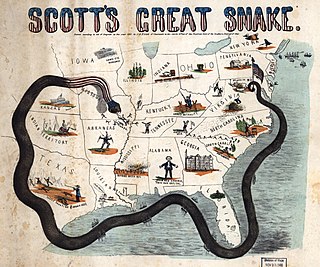
The Anaconda Plan was a strategy outlined by the Union Army for suppressing the Confederacy at the beginning of the American Civil War. Proposed by Union General-in-Chief Winfield Scott, the plan emphasized a Union blockade of the Southern ports and called for an advance down the Mississippi River to cut the South in two. Because the blockade would be rather passive, it was widely derided by a vociferous faction of Union generals who wanted a more vigorous prosecution of the war and likened it to the coils of an anaconda suffocating its victim. The snake image caught on, giving the proposal its popular name.

USS Advance, the second United States Navy ship to be so named, was later known as USS Frolic, and was originally the blockade runner Advance captured by the Union Navy during the latter part of the American Civil War. She was purchased by the Union Navy and outfitted as a gunboat and assigned to the blockade of the waterways of the Confederate States of America. She also served as dispatch ship and supply vessel when military action eventually slowed.

Atlanta was a casemate ironclad that served in the Confederate and Union Navies during the American Civil War. She was converted from a British-built blockade runner named Fingal by the Confederacy after she made one run to Savannah, Georgia. After several failed attempts to attack Union blockaders, the ship was captured by two Union monitors in 1863 when she ran aground. Atlanta was floated off, repaired, and rearmed, serving in the Union Navy for the rest of the war. She spent most of her time deployed on the James River supporting Union forces there. The ship was decommissioned in 1865 and placed in reserve. Several years after the end of the war, Atlanta was sold to Haiti, but was lost at sea in December 1869 on her delivery voyage.

Princess Royal was a British merchant ship and blockade runner that became a cruiser in the Union Navy during the American Civil War and later returned to civilian service.

CSSOwl was a blockade runner in the Confederate States Navy during the American Civil War. It was built by Jones Quiggen, a ship builder in Liverpool, England and launched on June 21, 1864.

The first USS Sassacus, a wooden, double-ended, sidewheel steamer in commission in the United States Navy from 1863 to 1865. She saw service in the American Civil War.

CSS Robert E. Lee was a fast paddle-steamer, originally built as a Glasgow-Belfast packet boat named Giraffe, which was bought as a blockade runner for the Confederate States during the American Civil War, then subsequently served in the United States Navy as USS Fort Donelson and in the Chilean Navy as Concepción.
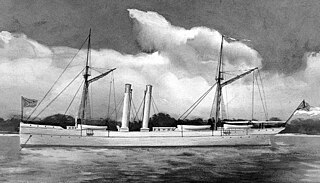
CSS Chickamauga, originally the blockade runner Edith, was purchased by the Confederate States Navy at Wilmington, North Carolina, in September 1864. In September, when she was nearly ready for sea, the Confederate Army sought unsuccessfully to retain her at that place for use as a troop and supply transport. On October 28, 1864, she put to sea under Lieutenant John Wilkinson (CSN) for a cruise north to the entrance of Long Island Sound, thence to St. George, Bermuda, for repairs and coal. She took several prizes before returning to Wilmington on November 19.

USS Fort Jackson was a wooden sidewheel steamer in the United States Navy during the American Civil War. She was successful in enforcing the Union blockade of Confederate ports, capturing five ships carrying contraband. She participated in the battles for Fort Fisher, which effectively closed the port of Wilmington, North Carolina to the Confederacy. Most notably, the surrender of Confederate forces in Texas was signed aboard the ship, formally ending the Civil War in that portion of the country.

Fort Fisher was a Confederate fort during the American Civil War. It protected the vital trading routes of the port at Wilmington, North Carolina, from 1861 until its capture by the Union in 1865. The fort was located on one of Cape Fear River's two outlets to the Atlantic Ocean on what was then known as Federal Point or Confederate Point and today is known as Pleasure Island. The strength of Fort Fisher led to its being called the Southern Gibraltar and the "Malakoff Tower of the South". The battle of Fort Fisher was the most decisive battle of the Civil War fought in North Carolina.

The Union blockade in the American Civil War was a naval strategy by the United States to prevent the Confederacy from trading.

USS Wilderness was a wooden-hulled, side-wheel steamship in the United States Navy during the American Civil War. After the war, she served as a revenue cutter. In 1873, she was renamed John A. Dix for former Secretary of the Treasury John Adams Dix.

PS Lelia was a steamship built in 1864, during the American Civil War for use as a blockade runner for the Confederate States of America. She sank in Liverpool Bay in 1865 in an incident that caused 46 fatalities.
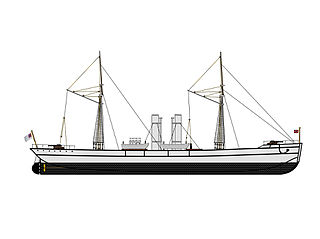
The CSS Tallahassee was a twin-screw steamer and cruiser in the Confederate States Navy, purchased in 1864, and used for commerce raiding off the Atlantic coast. She later operated under the names CSS Olustee and CSS Chameleon.

The USS Cherokee was a 606-ton screw steam gunboat in the US Navy during the American Civil War ship. The ship later served in the Chilean Navy.
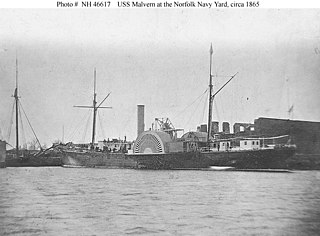
USS Malvern was a large steamer captured by the Union Navy during the American Civil War. She was then used by the Union Navy to patrol navigable waterways of the Confederacy to prevent the South from trading with other countries.
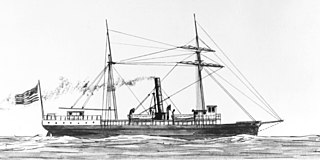
The passenger-cargo steamer Fah-Kee was launched in 1862 at Greenpoint, Brooklyn and operated on the United States coast until purchased in July 1863 by the Union Navy during the American Civil War. The Navy used USS Fahkee as a collier and freight supply ship assigned to assist Union Navy ships patrolling Confederate waterways.

USS Gertrude was the British blockade-running steamship Gertrude captured by the Union Navy during the American Civil War. She was placed in service by the Navy as a gunboat and assigned to patrol the southern coast of the United States for ships attempting to run the Union blockade of Southern ports. She was later the American merchant ship Gussie Telfair until wrecked in 1880.

During the American Civil War, blockade runners were used to get supplies through the Union blockade of the Confederate States of America that extended some 3,500 miles (5,600 km) along the Atlantic and Gulf of Mexico coastlines and the lower Mississippi River. The Confederacy had little industrial capability and could not indigenously produce the quantity of arms and other supplies needed to fight against the Union. To meet this need, numerous blockade runners were constructed in the British Isles and were used to import the guns, ordnance and other supplies that the Confederacy desperately needed, in exchange for cotton that the British textile industry needed greatly. To penetrate the blockade, these relatively lightweight shallow draft ships, mostly built in British shipyards and specially designed for speed, but not suited for transporting large quantities of cotton, had to cruise undetected, usually at night, through the Union blockade. The typical blockade runners were privately owned vessels often operating with a letter of marque issued by the Confederate government. If spotted, the blockade runners would attempt to outmaneuver or simply outrun any Union Navy warships on blockade patrol, often successfully.
SS Syren was a privately owned iron-hulled sidewheel steamship and blockade runner built at Greenwich, Kent, England in 1863, designed for outrunning and evading the Union ships on blockade patrol around the Confederate States coastline during the American Civil War. Owned by the Charleston Importing and Exporting Company, Syren made her first run on 5 November 1863, importing supplies for the Confederacy from Nassau to Wilmington. Syren completed a record 33 runs through the Union blockade, the most of any blockade runner, before invading Union forces captured her while Syren was berthed at Charleston Harbor.
References
- 1 2 3 Jones, David (1960). "Clifford Anderson Lanier". Georgia Review . 14 (2): 205–214.
- 1 2 Wise, Stephen R. (1988). Lifeline of the Confederacy. Columbia: University of South Carolina Press. pp. 206–8, 240–41, 249–50, 323. ISBN 0-87249-799-2.